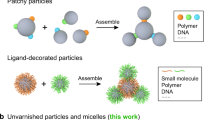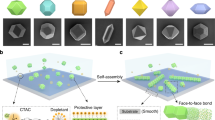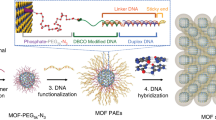Abstract
Colloidal nanocrystals exhibit a wide range of size- and shape-dependent properties and have found application in myriad fields, incuding optics, electronics, mechanics, drug delivery and catalysis, to name but a few1,2,3. Synthetic protocols that enable the simple and convenient production of colloidal nanocrystals with controlled size, shape and composition are therefore of key general importance4,5. Current strategies include organic solution-phase synthesis6, thermolysis of organometallic precursors4,7, sol–gel processes5, hydrothermal reactions8 and biomimetic and dendrimer templating9,10,11. Often, however, these procedures require stringent experimental conditions, are difficult to generalize, or necessitate tedious multistep reactions and purification. Recently, linear amphiphilic block co-polymer micelles have been used as templates to synthesize functional nanocrystals12,13, but the thermodynamic instability of these micelles limits the scope of this approach. Here, we report a general strategy for crafting a large variety of functional nanocrystals with precisely controlled dimensions, compositions and architectures by using star-like block co-polymers as nanoreactors. This new class of co-polymers forms unimolecular micelles that are structurally stable, therefore overcoming the intrinsic instability of linear block co-polymer micelles. Our approach enables the facile synthesis of organic solvent- and water-soluble nearly monodisperse nanocrystals with desired composition and architecture, including core–shell and hollow nanostructures. We demonstrate the generality of our approach by describing, as examples, the synthesis of various sizes and architectures of metallic, ferroelectric, magnetic, semiconductor and luminescent colloidal nanocrystals.
This is a preview of subscription content, access via your institution
Access options
Subscribe to this journal
Receive 12 print issues and online access
$259.00 per year
only $21.58 per issue
Buy this article
- Purchase on Springer Link
- Instant access to full article PDF
Prices may be subject to local taxes which are calculated during checkout




Similar content being viewed by others
References
Langer, R. Drug delivery and targeting. Nature 392, 5–10 (1998).
Wang, X., Zhuang, J., Peng, Q. & Li, Y. A general strategy for nanocrystal synthesis. Nature 437, 121–124 (2005).
Sun, S., Murray, C. B., Weller, D., Folks, L. & Moser, A. Monodisperse FePt nanoparticles and ferromagnetic FePt nanocrystal superlattices. Science 287, 1989–1992 (2000).
Peng, X. G. et al. Shape control of CdSe nanocrystals. Nature 404, 59–61 (2000).
Yang, P., Zhao, D., Margolese, D. I., Chmelka, B. F. & Stucky, G. D. Generalized syntheses of large-pore mesoporous metal oxides with semicrystalline frameworks. Nature 396, 152–155 (1998).
Murray, C. B., Norris, D. J. & Bawendi, M. G. Synthesis and characterization of nearly monodisperse CdE (E = sulfur, selenium, tellurium) semiconductor nanocrystallites. J. Am. Chem. Soc. 115, 8706–8715 (1993).
Park, J. et al. Ultra-large-scale syntheses of monodisperse nanocrystals. Nature Mater. 3, 891–895 (2004).
Liang, Y. et al. Co3O4 nanocrystals on graphene as a synergistic catalyst for oxygen reduction reaction. Nature Mater. 10, 780–786 (2011).
Chiu, C. et al. Platinum nanocrystals selectively shaped using facet-specific peptide sequences. Nature Chem. 3, 393–399 (2011).
Crooks, R. M., Zhao, M., Sun, L., Chechik, V. & Yeung, L. K. Dendrimer-encapsulated metal nanoparticles: synthesis, characterization, and applications to catalysis. Acc. Chem. Res. 34, 181–190 (2000).
Juttukonda, V. et al. Facile synthesis of tin oxide nanoparticles stabilized by dendritic polymers. J. Am. Chem. Soc. 128, 420–421 (2005).
Chai, J., Wang, D., Fan, X. & Buriak, J. M. Assembly of aligned linear metallic patterns on silicon. Nature Nanotech. 2, 500–506 (2007).
Nie, Z., Petukhova, A. & Kumacheva, E. Properties and emerging applications of self-assembled structures made from inorganic nanoparticles. Nature Nanotech. 5, 15–25 (2010).
Leong, W. L. et al. Non-volatile organic memory applications enabled by in situ synthesis of gold nanoparticles in a self-assembled block copolymer. Adv. Mater. 20, 2325–2331 (2008).
Riess, G. Micellization of block copolymers. Prog. Polym. Sci. 28, 1107–1170 (2003).
Darling, S. B. Directing the self-assembly of block copolymers. Prog. Polym. Sci. 32, 1152–1204 (2007).
Pang, X., Zhao, L., Akinc, M., Kim, J. K. & Lin, Z. Novel amphiphilic multi-arm, star-like block copolymers as unimolecular micelles. Macromolecules 44, 3746–3752 (2011).
Newkome, G. R., Moorefield, C. N., Baker, G. R., Saunders, M. J. & Grossman, S. H. Unimolecular micelles. Angew. Chem. Int. Ed. 30, 1178–1180 (1991).
Kidambi, S., Dai, J., Li, J. & Bruening, M. L. Selective hydrogenation by Pd nanoparticles embedded in polyelectrolyte multilayers. J. Am. Chem. Soc. 126, 2658–2659 (2004).
Kahr, B. & Gurney, R. W. Dyeing crystals. Chem. Rev. 101, 893–952 (2001).
Rohl, A. L., Gay, D. H., Davey, R. J. & Catlow, C. R. A. Interactions at the organic/inorganic interface: molecular modeling of the interaction between diphosphonates and the surfaces of barite crystals. J. Am. Chem. Soc. 118, 642–648 (1996).
Bullard, T. et al. Role of kinks in dyeing crystals: confocal luminescence microscopy from single molecules to square centimeters. Cryst. Growth Des. 9, 982–990 (2009).
Medintz, I. L., Uyeda, H. T., Goldman, E. R. & Mattoussi, H. Quantum dot bioconjugates for imaging, labelling and sensing. Nature Mater. 4, 435–446 (2005).
Zhang, J., Tang, Y., Lee, K. & Ouyang, M. Nonepitaxial growth of hybrid core–shell nanostructures with large lattice mismatches. Science 327, 1634–1638 (2010).
Palmstrom, C. J. Epitaxy of dissimilar materials. Annu. Rev. Mater. Sci. 25, 389–415 (1995).
Im, S. H., Jeong, U. & Xia, Y. Polymer hollow particles with controllable holes in their surfaces. Nature Mater. 4, 671–675 (2005).
Acknowledgements
The authors acknowledge funding support from the Air Force Office of Scientific Research (FA9550-09-1-0388 and FA9550-13-1-0101) and the Georgia Institute of Technology. The authors also thank Y. Xia and V. Tsukruk for helpful discussions.
Author information
Authors and Affiliations
Contributions
Z.L. and X.P. conceived and designed the experiments. X.P., L.Z., W.H. and X.X. performed the experiments. Z.L., X.P., L.Z., W.H. and X.X. analysed the data. Z.L., X.P. and L.Z. wrote the paper. All authors discussed the results and commented on the manuscript.
Corresponding author
Ethics declarations
Competing interests
The authors declare no competing financial interests.
Supplementary information
Supplementary information
Supplementary information (PDF 26238 kb)
Rights and permissions
About this article
Cite this article
Pang, X., Zhao, L., Han, W. et al. A general and robust strategy for the synthesis of nearly monodisperse colloidal nanocrystals. Nature Nanotech 8, 426–431 (2013). https://doi.org/10.1038/nnano.2013.85
Received:
Accepted:
Published:
Issue Date:
DOI: https://doi.org/10.1038/nnano.2013.85
This article is cited by
-
Precise solid-phase synthesis of CoFe@FeOx nanoparticles for efficient polysulfide regulation in lithium/sodium-sulfur batteries
Nature Communications (2023)
-
Metal halide perovskite nanorods with tailored dimensions, compositions and stabilities
Nature Synthesis (2023)
-
Templated synthesis of patterned gold nanoparticle assemblies for highly sensitive and reliable SERS substrates
Nano Research (2023)
-
Nanoreactors for particle synthesis
Nature Reviews Materials (2022)
-
Denary oxide nanoparticles as highly stable catalysts for methane combustion
Nature Catalysis (2021)



